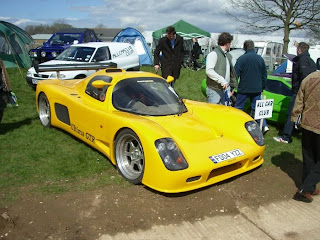The engine has been in the way at the back of the garage tripping one of us up most weekends for the last few months and today we can finally get it fitted. Before we can fit the engine we wanted to tidy it up a bit.
Engine Covers
We had previously cleaned the engine block with a wire brush but now it's time to respray some of the scratched engine covers.

The engine cover bolts are removed with a 5mm hex socket, 1/4 of a turn at a time. They vary in size so we marked their positions on some card. To keep the engine internals clean we covered the openings with cling film. The covers have very thin gaskets so we took care in removing them and cleaned them up. With some 400 grit wet and dry we removed the gloss from the paint finish and tried to get the most of the scratches from the metal out then degreased it with white spirit.

To paint the covers we're using Hammerite special metal primer applying it with a brush and then sanding it (800-1200 grit) once dry (after 2hrs) to give an even finish.

We sprayed the covers with a few coats of satin black and they ended up looking like this.

We aren't replacing the gaskets so we're using Loctite 5920 high performance silicon gasket which is rated upto 350oc. We can now torque the bolts up in the same sequence to their rated 12Nm.
Engine Fitment
To make it easier to fit the engine we took the chassis outside and placed it on blocks to raise the chassis to give the sump clearnance. We bolted the cradle to the engine using the original 3xR1 8mm cap head bolts. The top two bolts were left loose so that we had some movement to jiggle the engine to get all the other bolts in.

On the first engine fitment we found our fuel pipes were uncomfortably close to the timing chain cover. Knowing the SVA test is quite anal we decided it was best to move them now and be on the safe side while it was a simple task. We bent the return pipe and re-located the send line (picture highlighted below in sump fitment). We then lowered the engine into the chassis and pushed the 4xM12 loctited engine mount bolts with washers into the block with only a couple of threads. The cradle can then be secured using 4 shortened M12 bolts with washers and nylocs. With everything in position we could loctite and torque the botls upto their rated 45-55Nm.

The prop can then be attached to the bike engine sprocket adapter using 4 shortened M8 socket cap bolts with spring washers, loctite then tightened to 30Nm. With the engine in we can now fit the sump baffle, but first we need the chassis back in the garage and on the tressels. It's starting to get awkward and heavy to lift ourselves now, so with some help from friends Pete and Tom we got the chassis back home.
Sump Baffle
As the engine is mounted the wrong way round in cars like ours (compared to the bike setup) the engine needs a baffle plate or dry sump so the pump is not starved of oil when cornering at speed. A dry sump is the best way to go but R1's seem to respond fine to just the baffle which is a few hundred pounds cheaper and lighter; bonus! We started by removing the 5mm hex bolts in sequence similar to that of the engine covers, 1/4 of a turn at a time in an opposite to opposite cris cross manner.

Like head bolts to keep check of them we secured them in place on some card board as they're all different sizes.

After some beating with a hammer and a stick the sump comes off but at the same time ruining the gasket; I think a new one is needed. We looked at our CNC'd baffle plate and to fit it we need to remove the oil strainer (with the mesh and 2 bolts) the oil deilvery pipes ("U" shaped pipe with 2 bolts) and vertical pipe with 1 bolt). The plate has holes made for these items so that once the bolts are put back in they hold the baffle in place. There are also two other holes that have 'engine metal' behind them which I have circled below. These are just metal webs that we can drill, tap to size and use bolts to fix the baffle more evenly and thus more securely.

After a little trimming of the plate and the holes made we can attach it. We cleaned then fitted vertical oil pipe, delivery pipe and strainer back in place and added the new bolts.

We fitted a new gasket with some sealant after we removed all traces of the old gasket. Then we re-fitted the sump and did the botls up to 12Nm in the same sequence as before.























